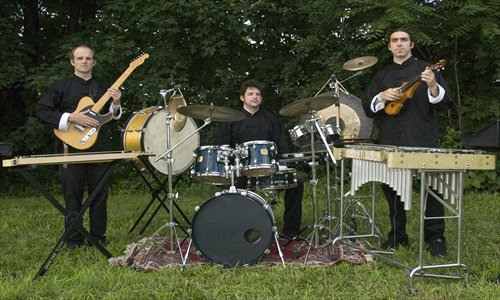
Devil Music Ensemble
Violence, terror and bikini-clad concubines form an unlikely cinematic formula dating back nearly a century in Shanghai.
Such is the scene in 1929 silent martial arts film Red Heroine. The movie will be screened with a live performance of an original soundtrack by US-based composer collective Devil Music Ensemble (DME) at Tango 3/F, as part of the group's seven-city China tour.
"There are brutal points, dark scenes and weird comedy," said Jonah Rapino, violinist from DME, of the film. "Early cinema was a time of experimentation. It was going places where there was no precedent."
According to the China Film Archive in Beijing, only a handful of the over 200 martial arts films made during Shanghai's golden age of cinema (1927-1931) survived. Red Heroine is not only the sole remaining installment of its original 13-part series, it is also the only known complete example remaining from that era.
"Who knows why Red Heroine still exists?" mused guitarist and DME founder, Brendan Wood. After seeing the 94-minute film in 2004 at a Boston-area film festival, he started the long, arduous process of acquiring screening rights.
"The first problem was figuring out who to talk to," explained Wood of the process. "We decided to call the China Film Archive at midnight. I was nervous and felt kind of dumb." After years of investigating, the film was eventually traced to Poly-Huayi of China, the amalgamation of Poly Media Asia and the Huayi Brothers.
Even before the Shaw Brothers codified kung fu cinema in the 1950s, there was wuxia; a blend of pulp, swordplay and mystical Taoism, with Red Heroine serving as a classic example.
The film focuses on young maiden Yun Ko, played by Jiangsu-native and pioneering kung fu actress, Fan Xuepeng (1908-1974). Considered the Michelle Yeoh of her time, Fan went on to make numerous "red dramas", contributions for which she was given the title "Advanced Worker."
In Red Heroine, after Yun Ko is kidnapped by raiding soldiers and forced to serve in a lecherous general's harem, she is saved by a mystic Taoist dubbed White Monkey.
Three years later, Yun Ko reemerges an empowered warrior, bestowed with powers learned from White Monkey. She exacts revenge flying around, stabbing enemies and rescuing the innocent. Wood explained that the writing process began with "popcorn and notebooks." The band outlined transitional points and characters, and worked out themes through collective improvisation.
"When I started playing the erhu, I thought it sounded terrible," noted Rapino of the traditional Chinese two-stringed fiddle. Already an accomplished violinist, he he took one lesson in Boston's Chinatown from an erhu virtuoso.
Rapino employs the recognizable melody "Riverwater" by erhu composer A-Bing as a leitmotiv for White Monkey. "It's a heavy, heart-stirring sound that pierces straight to the soul," he said of the haunting melody.
Armed with an array of instruments from lap guitars to cacophonous percussion, DME's 90-minute soundtrack is best described as post-rock meets Peking Opera, an American musical take with Chinese characteristics on a film finding its way home.
"The coolest thing about our trip is that we're presenting this to people who created it," said Rapino. "We could get it totally wrong, but who knows? It's going to be an amazing conversation."

Copyright ©1999-2011 Chinanews.com. All rights reserved.
Reproduction in whole or in part without permission is prohibited.